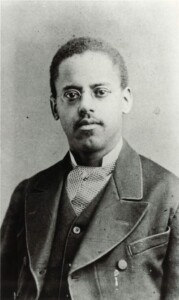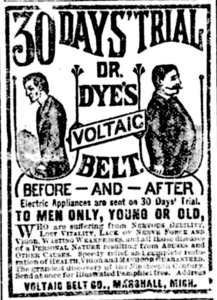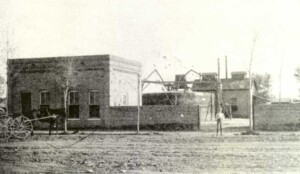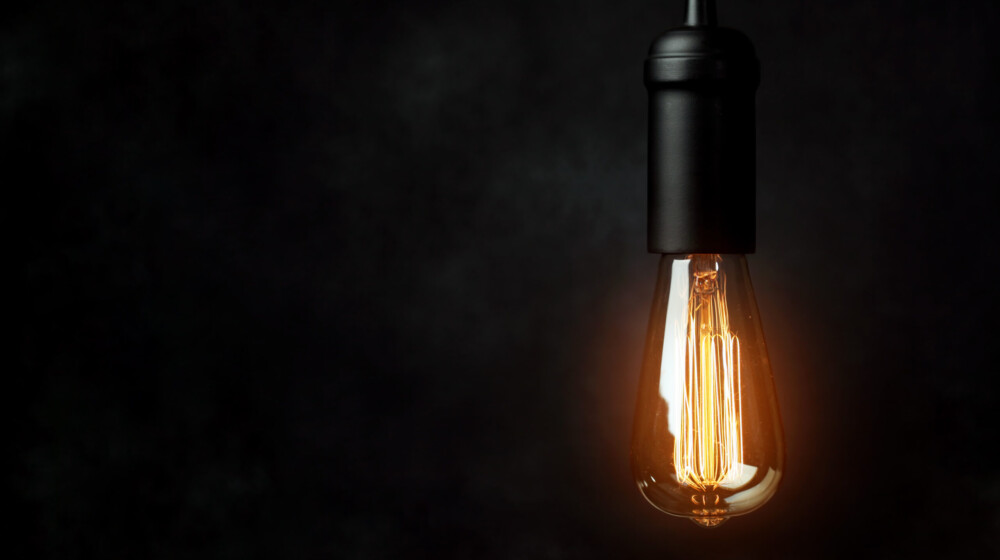It’s Electric
Did you know…
People are often surprised by the fact that Rosson House had electric lighting when it was first built, and that electricity was even available in Phoenix at that time. But, as we can see from this excerpt from this Whitelaw Reid letter, that was true in the 19th century as well as the 21st:
 When the sun would set, the biggest and most consistent form of light and warmth in the home, prior to electric lighting, was always the hearth. You could sit and read or sew there, but its light was always limited in reach, as was the light produced by candles, oil lamps, or (new in the mid-1800s) kerosene or gas lamps. These light sources were sometimes cost prohibitive, produced smelly fumes, smoke, and soot, and were often a household danger. Tips were given in newspapers well into the 1900s on how to avoid household fires from open flames and even explosions from kerosene lamps and stoves, but they often ran beside stories that told of lives and homes lost due to unintended carelessness. When electric lights became available, they were promoted as a safer alternative to open flame lighting.
When the sun would set, the biggest and most consistent form of light and warmth in the home, prior to electric lighting, was always the hearth. You could sit and read or sew there, but its light was always limited in reach, as was the light produced by candles, oil lamps, or (new in the mid-1800s) kerosene or gas lamps. These light sources were sometimes cost prohibitive, produced smelly fumes, smoke, and soot, and were often a household danger. Tips were given in newspapers well into the 1900s on how to avoid household fires from open flames and even explosions from kerosene lamps and stoves, but they often ran beside stories that told of lives and homes lost due to unintended carelessness. When electric lights became available, they were promoted as a safer alternative to open flame lighting.
-
Bright Ideas
 We always associate Thomas Edison with inventing the light bulb, but many scientists experimented with electric lighting throughout the 19th century, trying to create a light that was safe, affordable, and practical for everyday use. This included electrical pioneer, Lewis Latimer, whose parents escaped slavery and fled to Massachusetts, where Lewis was born. As a 16 year old, he enlisted in the US Navy during the Civil War. After the war Lewis taught himself mechanical drawing, and worked as a draftsman and a patent consultant with a couple other well-known inventors – Alexander Graham Bell and Thomas Edison. He patented several of his own inventions, too, including an early air conditioning unit, a restroom for railway cars, and the carbon filament used in incandescent light bulbs (and would write a book about the Edison light). In his spare time, Latimer wrote poetry, played the flute, and taught immigrants English and mechanical drawing. Built in 1887, Lewis Latimer’s home in New York still stands, now as a museum dedicated to civil justice and STEM learning – you can discover more about Lewis Latimer on their website.
We always associate Thomas Edison with inventing the light bulb, but many scientists experimented with electric lighting throughout the 19th century, trying to create a light that was safe, affordable, and practical for everyday use. This included electrical pioneer, Lewis Latimer, whose parents escaped slavery and fled to Massachusetts, where Lewis was born. As a 16 year old, he enlisted in the US Navy during the Civil War. After the war Lewis taught himself mechanical drawing, and worked as a draftsman and a patent consultant with a couple other well-known inventors – Alexander Graham Bell and Thomas Edison. He patented several of his own inventions, too, including an early air conditioning unit, a restroom for railway cars, and the carbon filament used in incandescent light bulbs (and would write a book about the Edison light). In his spare time, Latimer wrote poetry, played the flute, and taught immigrants English and mechanical drawing. Built in 1887, Lewis Latimer’s home in New York still stands, now as a museum dedicated to civil justice and STEM learning – you can discover more about Lewis Latimer on their website.
Cleveland, OH was the first city to use electricity to light its streets on April 29, 1879, using 12 powerful arc lamps (invented by Cleveland resident, Charles Brush) to light their public square. Other cities installed electrical lighting in the years following – San Francisco in 1879, Salt Lake City in 1881, Manhattan and Albuquerque in 1882, Pittsburgh, Seattle, San Diego and Denver in 1886, and Phoenix in 1887. By contrast, the White House wasn’t electrically lit until 1891, and then-President Benjamin Harrison and the First Lady wouldn’t touch the light switches or stay too near the fixtures/bulbs, for fear of being electrocuted.
-
How Shocking!
 In an era when you can see many people doing stupid things on TV and social media, we know you won’t be surprised when we tell you that Victorians used electricity for more than just lighting their homes and running their rudimentary electric fans and toasters. One of the more interesting ways they used electricity was in medicine. To be fair we use it today, too, as everyone who has seen a medical drama on TV would agree. But to Victorians, electricity was a mysterious element that could treat headache, hysteria, rheumatism, heart palpitations, dropsy and piles, fatigue and general nervous complaints, diarrhea, dyspepsia and other digestive maladies, and even problems with virility! If you’ve been to Rosson House, you’ve seen the Hall’s Portable Magnetic Machine for Nervous Diseases that we have in the doctor’s office, but they also made belts people could wear to get sets of electric shocks throughout the day – ouch!
In an era when you can see many people doing stupid things on TV and social media, we know you won’t be surprised when we tell you that Victorians used electricity for more than just lighting their homes and running their rudimentary electric fans and toasters. One of the more interesting ways they used electricity was in medicine. To be fair we use it today, too, as everyone who has seen a medical drama on TV would agree. But to Victorians, electricity was a mysterious element that could treat headache, hysteria, rheumatism, heart palpitations, dropsy and piles, fatigue and general nervous complaints, diarrhea, dyspepsia and other digestive maladies, and even problems with virility! If you’ve been to Rosson House, you’ve seen the Hall’s Portable Magnetic Machine for Nervous Diseases that we have in the doctor’s office, but they also made belts people could wear to get sets of electric shocks throughout the day – ouch!

The Phoenix Illuminating Gas & Electric Light Company (The Sheriff Magazine, December 1955)
The Phoenix Illuminating Gas & Electric Light Co. was established in 1886 after three Arizona men (including Japanese immigrant, Hachiro Onuki, who went by Hutchlon Ohnick) were given permission by the City Council to provide Phoenix with gas and electric lighting in April. They were able to begin providing gas to businesses on December 22nd, and electricity the next year. The company and the Phoenix Electric Light Co. were both listed in the 1888 City Directory. In 1899, the two companies merged. Mr. Onuki had sold his share of the business in 1896.
Learn about the excavation of the area where the Phoenix Illuminating Gas & Electric Light Co. once stood from this article in Desert Archaeology, Inc.
Learn about the first electric Christmas lights in our article from December 2016.
Information for this article was found in Enlightening the Past: The Phoenix Illuminating Gas & Electric Light Company, J. Homer Thiel, 2002; the Cleveland Magazine; the Milwaukee Public Museum; the UK Science Museum; and the Library of Congress Chronicling America digital newspaper archive.
